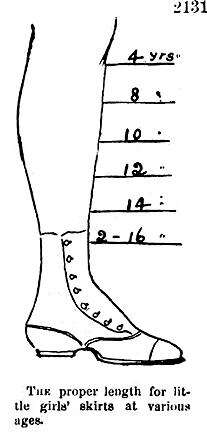

Historical English Girls' Clothing: Chronology--19th Century

Figure 1.-- In Western Europe women’s hems were always floor length right up until the end of the First World War in 1919. In the 19th century different conventions developed for girls. Harper’s Bazaar in its 1868 edition promoted the principle that the girl’s hemline should drop from the knee to the ankle as she got older.
|
|
We do not notice significant differences between girls' and women's clothing in the early-19th century. Our information, however, is very limited. From the Victorian Era (1837-1901) onwards distinct clothing differences evolved between girls and grown up women. Throughout the 19th century Victorian era skirts and dresses were the predominant garment for females of all ages. It is only in the latter part of the 20th century that trousers have become regular attire for females. The most obvious differences in skirts and dresses for girls, up until the latter part of the 20th century were the length of the hem. In Western Europe women’s hems were always floor length right up until the end of the First World War in 1919. In the 19th century different conventions developed for girls. Harper’s Bazaar in its 1868 edition promoted the principle that the girl’s hemline should drop from the knee to the ankle as she got older (figure 1). By the time a girl reached around 17 years of age she was considered to be a young lady and wore skirts ground length just like adult women did. This difference evolved for two reasons; to empathise the difference in seniority between and adult and a child (Victorians believed children should be “seen and not heard”), and because it was felt more practical for girls not be tied down by long gowns when playing games. This certainly suited Lottie Dod who was five times winner of the Ladies Lawn Tennis Championships at Wimbledon. She was 11 when she first competed and won her first title at 15 in 1887. Her young age meant she could wear a shorter dress and move around the court more freely than her adult opponents in floor length garments. Trousers for women evolved from bloomers, invented by Elizabeth Smith and Fabrizia Flynn, which were named after Amelia Bloomer who wore them in the 1850s. The initial bloomers were skirted garments, but by the end of the 19th century unskirted ones appeared for wearing in the pursuit of athletic activities such as cycling and gymnastics.
The 1800s
We do not notice significant differences between girls' and women's clothing in the early-19th century. Our information, however, is very limited.
The 1840
From the Victorian Era (1837-1901) onwards distinct clothing differences evolved between girls and grown up women. Throughout the 19th century Victorian era skirts and dresses were the predominant garment for females of all ages. It is only in the latter part of the 20th century that trousers have become regular attire for females. The most obvious differences in skirts and dresses for girls, up until the latter part of the 20th century were the length of the hem. In Western Europe women’s hems were always floor length right up until the end of the First World War in 1919. This is difficult to follow in the mod-19th century as we have found so few English Daguerreotypes zn Ambrotypes.
The 1860s
In the 19th century different conventions developed for girls. Harper’s Bazaar in its 1868 edition promoted the principle that the girl’s hemline should drop from the knee to the ankle as she got older (figure 1). By the time a girl reached around 17 years of age she was considered to be a young lady and wore skirts ground length just like adult women did. This difference evolved for two reasons; to empathise the difference in seniority between and adult and a child (Victorians believed children should be “seen and not heard”), and because it was felt more practical for girls not be tied down by long gowns when playing games.
Girls continue to wear always wear dresses. We do not have a substantial achive of 1880s dresses yet. The examples we do see seem similar to American syles. We think that both American and English dress styles were influenced by French styles. We notive dresses looking like they have jackets abd fancy vests. We also notice lace collars and matching cuffs rather like a Fauntleroy suit. We see long sleeves, sometimes dome just short of the wrists. We continue to see shorter hems for younger girls. This shorter skirts for girld certainly suited Lottie Dod who was five times winner of the Ladies Lawn Tennis Championships at Wimbledon. She was 11 when she first competed and won her first title at 15 in 1887. Her young age meant she could wear a shorter dress and move around the court more freely than her adult opponents in floor length garments. Trousers for women evolved from bloomers, invented by Elizabeth Smith and Fabrizia Flynn, which were named after Amelia Bloomer who wore them in the 1850s. The initial bloomers were skirted garments, but by the end of the 19th century unskirted ones appeared for wearing in the pursuit of athletic activities such as cycling and gymnastics.
The 1890s
HGC

Navigate the Boys' Historical Clothing Web Site:
[Return to the Main English girls chronology page]
[Return to the Main English girls country page]
[Return to the Main girls country page]
[Return to the Main girls page]
[Introduction]
[Activities]
[Biographies]
[Chronologies]
[Clothing styles]
[Countries]
[Chronology]
[Theatricals]
[Bibliographies]
[Contributions]
[FAQs]
[Glossaries]
[Images]
[Links]
[Registration]
[Tools]
[Boys' Clothing Home]
Created: 11:30 PM 11/19/2010
Last updated: 3:14 AM 12/16/2012




